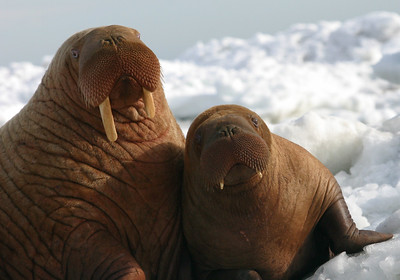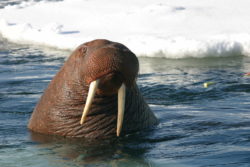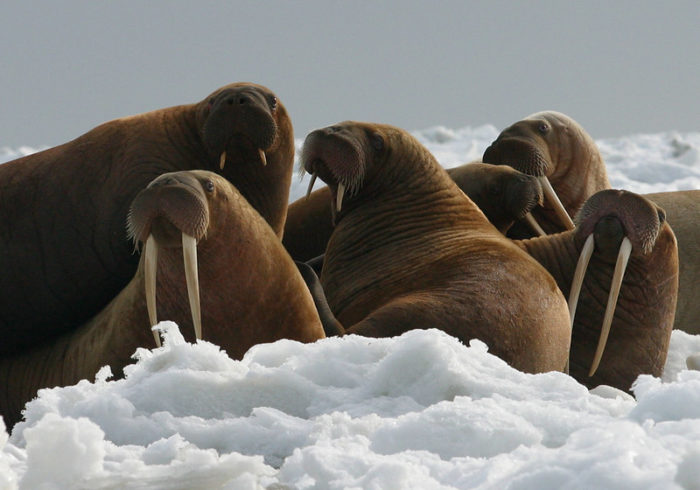
Sea Wonder: Walrus

Photo Credit: USFWS/Joel Garlich-Miller
Walruses (Odobenus rosmarus) are some of the most recognizable pinnipeds in the world, with pink-brown hides, thick whiskers, and white tusks protruding from their mouths. While they are not evolutionarily related, walrus tusks are quite similar to those of elephants, as both are made of dentin or enamel and they grow throughout the animals’ lifetimes.
Description
Walruses are large marine mammals with thick, tough hides that can be up to an inch thick, not to mention their blubber layer that keeps them warm in chilly waters. Their tusks help them haul their massive bodies out of the water and to break breathing holes into ice sheets while underwater. The tusks can grow to be about three feet long and are found on both males and females. Adult males (also called bulls) are larger than adult females, reaching lengths of 12 feet and weighing up to 4,000 pounds! Females, while smaller, can still weigh more than 2,000 pounds when fully grown.
Diet and Habitat
Walruses feed on marine invertebrates like clams, snails, worms, sea cucumbers, and tunicates. They use their sensitive whiskers (called vibrissae) to detect movements along the seafloor before digging their targets out with their mouths. Walrus teeth are flat – except for their tusks, of course – so they use powerful suction to draw food into their mouths, which they create by moving their tongue back quickly and forcefully.
Walruses live near the Arctic circle, leveraging ice packs and rocky shorelines. In the hemispheric winter months, walruses are commonly gathered on the Bering Sea ice pack, in the spring these larger groups separate. Females and their pups migrate northward towards the Chuckchi Sea while independent juveniles and adult males head for Bristol Bay. They forage and are most active during the warmest months of the year, and by late fall, walruses migrate back to the Bering Sea.
Life History

Photo Credit: USFWS/Joel Garlich-Miller
Experts believe that the maximum lifespan for a walrus is about 40 years, with females reaching maturity at around six years of age and males reaching maturity between eight and 10 years of age. Adult males are quite territorial and aggressive, and mature males generally cannot physically compete with older males until they are at least 15 years old.
Mating season occurs between December and March, when walruses gather on thick ice packs. To find a mate, males stake out and guard their territories on land near resting females, and to attract the attention of females, males spar with their tusks and make a variety of vocalizations like whistles and thumping noises. Mating behavior takes place offshore and underwater, making breeding locations difficult to find or observe.
Female walruses generally only mate with one male per season and give birth to a pup every two or three years. The strongest male walruses, on the other hand, will mate with several (and up to a dozen) females each year. A walrus pregnancy lasts about 16 months and pups stay with their mothers for up to three years before they become fully independent. Walrus pups nurse from their mothers for approximately a year, incorporating more live food into their diets as their bodies develop and they learn to forage.
Threats and Conservation
Walrus populations are listed on the IUCN Red List as vulnerable to extinction. Their natural predators include orcas and polar bears, and anthropogenic threats like pollution, ship strikes, entanglement in marine debris, reduced food availability due to ocean acidification, and disappearing sea ice due to climate change. Reductions in sea ice affect walruses in several ways: by making it harder for them to spread out or rest, forcing them to travel farther out to sea to forage, and making them more vulnerable to predation. Walruses also receive protection in the United States under the Marine Mammal Protection Act of 1972 and do not currently receive any special protections under the Endangered Species Act of 1973.

Photo Credit: USFWS/Joel Garlich-Miller
